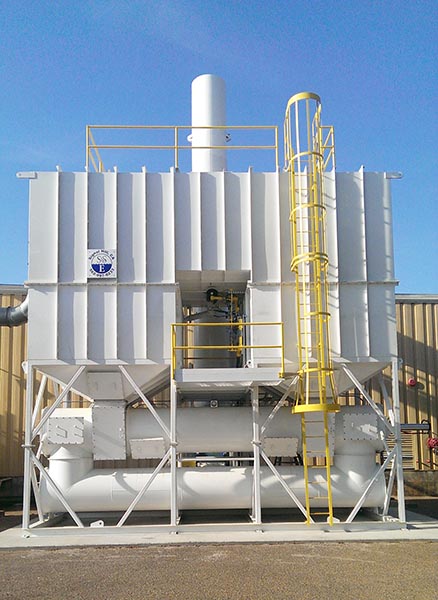A lot of the discussion around volatile organic compounds (VOCs) has revolved around creating a safer workplace in printing and packaging companies using solvents—both in flexo platemaking and in the press room. But what happens when VOCs exit the building’s exhaust system?
According to the U.S. EPA, “Volatile organic compounds are compounds that have a high vapor pressure and low water solubility [and] typically are industrial solvents, such as trichloroethylene.…VOCs are emitted by a wide array of products numbering in the thousands. Examples include: paints and lacquers, paint strippers, cleaning supplies, pesticides, building materials and furnishings, office equipment such as copiers and printers, correction fluids and carbonless copy paper, graphics and craft materials including glues and adhesives, permanent markers, and photographic solutions.”
In that list, you probably see several things that are common in your production environment—and even in your office environment. Another emission we probably don’t think much about but which can be equally harmful to our planet when emitted into the atmosphere is ozone, a chemical that is made of three oxygen atoms joined together. The EPA’s Acid Rain Glossary notes that there are two types of ozone: good and bad. “Good ozone is found high in the Earth's atmosphere, and prevents the sun's harmful rays from reaching the Earth. Bad ozone is found low to the ground, and can be harmful to animals and humans because it damages our lungs, sometimes making it difficult to breathe.” Ozone has a very characteristic pungent odor, sometimes described as like chlorine bleach, and it can sometimes be detected after lightning strikes or during electrical discharges, according to the California Air Resources Board.
Understanding what these emissions are is one thing; preventing them from getting into our fragile atmosphere is another. That’s why we were intrigued when we saw a press release from Ship & Shore Environmental, Inc. about their Regenerative Thermal Oxidizer solutions, or RTOs, a new term for me, and likely for you as well. We spoke with Ship & Shore CEO and President Anoosheh Oskouian to learn more.
WhatTheyThink: Anoosheh, thank you for speaking to us. Let’s start with a brief overview of Ship & Shore Environmental.
 Anoosheh Oskouian: Our company specializes in design, engineering and manufacturing of pollution control systems, which are mostly related to VOCs and any emissions that may be coming off of any industrial facility, of any size, that are not allowed to go out to the atmosphere and have to be captured and controlled. That is usually governed by the rules and regulations in various counties and states all around the country.
Anoosheh Oskouian: Our company specializes in design, engineering and manufacturing of pollution control systems, which are mostly related to VOCs and any emissions that may be coming off of any industrial facility, of any size, that are not allowed to go out to the atmosphere and have to be captured and controlled. That is usually governed by the rules and regulations in various counties and states all around the country.
WTT: We recently saw some information about your regenerative thermal oxidizers (RTOs), especially as it relates to the flexographic industry. I know from working in the industry that more than 70% of flexographic operations use solvent-wash plates, as well as solvents in other parts of the operation, including the press room. Can you explain what RTOs are and how that relates to making the flexographic printing industry more sustainable and why they are important?
AO: RTOs, and as you fully have stated the name, regenerative thermal oxidizers, are a system that is designed to capture not only all the VOCs and the emissions from solvent use within the printing industry, but disrupt it and get rid of it, for lack of better words, in a much more efficient way, rather than just, sending it through a regular thermal oxidizer. In the olden days, if people had to do emission removal, they always looked into thermal oxidizers or a recuperative unit that had a heat exchanger, and that caused a lot of other problems. We came up with a very unique design that captures all the heat that has been generated as a result of the VOCs that go through the system, and it retains most of the heat inside through a special ceramic media. So a very small amount of additional heat has to be created with the burner of the unit. As a result, companies do not have to use a lot of natural gas, just very small amount to just get the system started up, be able to disrupt all the emissions that are coming through the unit.

Regenerative Thermal Oxidizer Technology (RTO). RTO achieves 98% to 99% destruction efficiency and 95% to 97% nominal thermal efficiency.
WTT: So what you are saying is that it neutralizes those emissions? Am I understanding that correctly?
AO: The word neutralizing is correct; however, basically through a process of combustion, it uses the VOCs and the solvents that have very high heating value as a source to take it through the process. And on the other side where the stack of the unit is, or the chimneys, some people refer to it, you basically output clean air. We remove about 98% of the pollutants. And in occasions where they need 99%, we have 99% removal and destruction of those pollutants by our systems. I should also mention that another contaminant we can remove with these systems is ozone, emissions of which are also controlled by regulatory agencies.
WTT: Do you see most of these emissions coming from the platemaking operation?
AO: That’s part of it, certainly. But the other reason there are increased emissions has to do with the use of solvent inks on packaging that has a much higher percentage of ink coverage due to the demand for more graphics on packaging, including films, plastic bags, stand-up pouches and more. That’s one of the reasons we are having to deal with a lot more solvents and a lot more VOC emissions that can be collected and neutralized by our systems instead of being released into the atmosphere.
WTT: Ultimately, brands and retailers will be required to report on Scope 3 emissions, which includes the entire supply chain behind their products, cradle to grave. And that includes printing. When you are out talking to the market, are you usually talking to the brands and retailers or the producers?
AO: Ninety-five percent of the time, we are talking to the manufacturers and the flexographic operations that produce all of the packaging for the end users. Sometimes there are companies that are the producers of the product that goes inside the packaging that are interested in knowing the impact of the packaging on Scope 3 emissions.
WTT: So an RTO is an item that they add to their external exhaust fans?
AO: It’s a good-sized piece of equipment that usually sits outside of their facility. We do an assessment of the facility on the production floor to determine how best to collect the exhaust that is coming off of each one of the ducts they have on their roof. One RTO system can collect the emissions from all of the exhaust ducts and provide clean air on the other side.

Modular Construction of an RTO Inlet and Outlet Manifold for fast and easy bolt together construction.
WTT: Where can readers get more information about these systems?
AO: They can visit us at www.shipandshore.com. They can read about the technology, take a look at some of the applications, and check out our technical write-ups.
WTT: I’m assuming that especially larger packaging and other printing operations are starting to get some pressure from their customers and/or regulatory agencies to reduce or eliminate those emissions. So your analysis can tell them what is going into the air in terms of VOCs and ozone, and they can make a decision from there?
AO: Absolutely. I have been involved with this industry for many years, and most recently, we are noticing that not only the brands and retailers, but also consumers, are much more interested in making sure they buy from companies that are environmentally conscious.
WTT: These look like large systems. What is the price range, and do you have systems that are affordable for smaller companies?
AO: There is no ballpark figure as systems can start from $100K to $1 million depending on the size of the operation and number of presses and laminators running. However, there are many innovative approaches to reduce cost effectively and efficiently. We provide systems for a small facility and operation to multi location billion dollar operations. As a customized system provider, we are able to accommodate based on the client’s need and requirements.
WTT: I know you are located in California, which seems to lead the way in implementing a lot of the environmental regulations. But do you see this happening in other regions as well?
AO: As you mentioned, we are in California where a lot of major rules and regulations and environmental rules are very tight. However, we're noticing that a lot of other states are following the footsteps of what is going on in California. We do work in all the states, as well as Canada and a number of other locations. We are seeing increasing interest in solving the problems that our solutions help with, and we are pleased about being able to help with reducing the amount of pollution that goes into our atmosphere.
Author’s Note: While systems like this look like a big—and perhaps optional—expense, printing and packaging companies should be planning to implement them, as eventually they will be required to do so. What you don’t want is to end up with investigations or in court like Tesla in California which will end up costing more, financially and in aggravation, than proactively investing in systems that emit clean air.

Image compliments of Ship & Shore Environmental.
EDITOR’S NOTE: View the complete conversation here.














